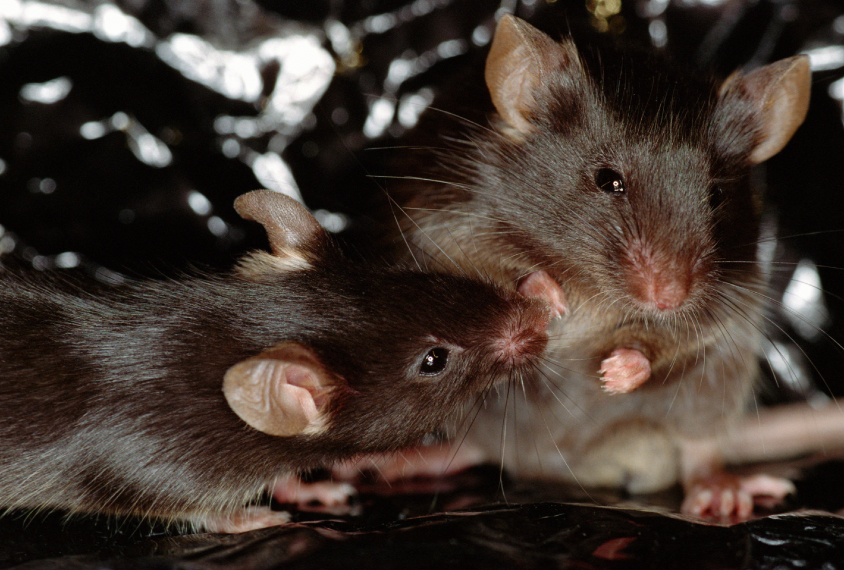
Drug boosts social behavior in mice with deletion tied to autism
A drug that has shown promise for treating fragile X syndrome may ease features of another condition associated with autism.
A drug that has shown promise for treating fragile X syndrome eases features of another condition associated with autism, suggests a new mouse study1.
The study shows that the drug, arbaclofen, improves cognitive and social functioning in mice missing a chromosomal region called 16p11.2. Many children with the deletion have some autism features, and nearly one-third have autism.
Arbaclofen reverses brain abnormalities and behavioral problems in a mouse model of fragile X syndrome. Results in people have been mixed.
“It’s kind of exciting that this same approach that works in fragile X also seems to work in this other, much more complex genetic disorder,” says co-lead investigator Mark Bear, professor of neuroscience at the Massachusetts Institute of Technology in Cambridge.
The researchers studied two strains of mice, each with a slightly shifted deletion in 16p11.2. Arbaclofen improves cognitive functioning in both strains; in one strain, it also eases social problems.
“It’s exciting to see that there’s a change that can be assessed at the level of cognition, as well as a change in social function,” says Jeremy Veenstra-VanderWeele, professor of psychiatry at Columbia University, who was not involved in the research.
Memory repair:
The 16p11.2 region encompasses nearly 30 genes. Deletions of the region are associated with intellectual disability, seizures, schizophrenia and autism. Duplications of the region are also tied to autism.
Mice with 16p11.2 deletions display a range of brain and behavioral abnormalities. For example, they show excessive protein synthesis at the junctions between neurons. They also have repetitive behaviors and memory problems, and are less responsive to certain social cues. Mouse models of fragile X syndrome also show many of these features.
Arbaclofen may work by calming an overactive brain: It activates receptors for a chemical messenger called GABA that dampens brain activity. A 2015 study showed that the drug at least partially reverses the social deficits and excessive protein synthesis in fragile X mice. It also corrects social impairments and repetitive behaviors in so-called BTBR mice, which show some social behavior reminiscent of autism2.
These results prompted the researchers to test it in mice with 16p11.2 deletions.
Bear’s team collaborated with a team led by Jacqueline Crawley at the University of California, Davis. Each team independently studied a strain of 16p11.2 mice missing a specific set of genes within the region. Some of the mice of each strain received arbaclofen beginning at various ages, from 6 weeks to nearly 6 months.
After about one to two weeks, the researchers tested the rodents’ learning and memory. Mice treated with arbaclofen recognize novel objects, remember object locations and retain information about the environment significantly better than the untreated mice. Their memory appears to match that of control mice.
“The improvement was quite dramatic,” Bear says. The results appeared 6 October in Neuropsychology.
Following females:
Crawley’s team also observed the animals’ social interactions. In earlier work, her team showed that a strain of mice missing the 16p11.2 region have social impairments. The mice spend less time interacting with an unfamiliar female mouse and vocalize less during these interactions than controls do3.
Arbaclofen ameliorates some of these social deficits, the new study found. Although the drug does not increase vocalizations, treated male mice spend more time sniffing and following female mice than controls do.
“This is a very carefully done, very elegant behavioral pharmacology study,” Veenstra-VanderWeele says.
The results suggest that similar mechanisms underlie multiple conditions associated with intellectual disability and autism, Bear says. Exactly how arbaclofen alters biology in 16p11.2 deletion mice is unknown, however.
It is also unclear whether the findings apply to people. Clinical trials hint that arbaclofen eases social problems, irritability and other features in some children with autism or fragile X syndrome. But the drug only seems to work in a subset of individuals, and some findings have fallen just short of statistical significance.
“We have a lot of positive effects in mouse models, and they’ve been very challenging to translate clinically,” says Elizabeth Berry-Kravis, professor of child neurology at Rush University in Chicago, who was not involved in the new study.
The researchers are part of an international consortium that is testing the effects of arbaclofen on behavior in different strains of 16p11.2 deletion mice.
References:
Recommended reading

New organoid atlas unveils four neurodevelopmental signatures
Explore more from The Transmitter

The Transmitter’s most-read neuroscience book excerpts of 2025

Neuroscience’s leaders, legacies and rising stars of 2025


